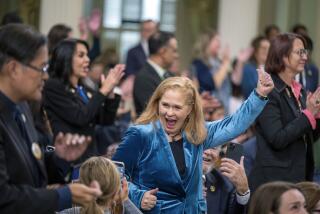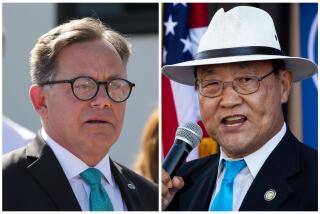Editorial: Time to get off the special election merry-go-round
California voters this year were again faced with a slew of special elections to fill vacant seats in the Legislature. But the job of filling the 32nd Senate seat has been especially confusing. Two primary elections for the seat were held on the same ballot on June 5 — one to find candidates to fill the empty seat for the short term and another to find candidates to fill it for the longer term.
That was silly in its own right, but then, to make matters worse, voters chose different candidates to advance to the runoff in the two elections, even though the slate of people running was exactly the same. It’s hard to follow, we know, but the bottom line is this: There is a real possibility that the winner of the short-term runoff that was held Tuesday will represent the district for just three weeks before the legislative session ends. Then in December, she could be out of the job entirely.
What a waste of money and effort! If there was ever a poster child for special election reform, this is it.
This latest round of vacancies in the Legislature was brought on by the sexual harassment scandals that have rocked the Capital over the last year. Sen. Tony Mendoza (D-Artesia), who held the 32nd Senate seat, and two members of the Assembly all resigned amid allegations of sexual misconduct. Assemblyman Sebastian Ridley-Thomas (D-Los Angeles) stepped down for health reasons.
Special elections are expensive — typically more than $1 million each — with local governments footing the bill.
State law lays out a strict timeline that the governor must follow when filling vacancies in the Legislature. A special election must be announced within two weeks and held within 126 to 140 days, unless there is a regularly scheduled election occurring sooner or immediately afterward.
Sometimes there’s an opportunity to consolidate the special election with regularly scheduled elections. But often, county elections officials have to arrange stand-alone special elections, which tend to draw extremely few voters because, well, who’s expecting an election on a Tuesday in April or August? And why turn out for just one race? As a result, it’s not unusual to see fewer than 15% of registered voters cast ballots.
Such special elections are expensive — typically more than $1 million each — with local governments footing the bill. And they’ve become more frequent as term-limited politicians quit midyear to run for higher office. One resignation triggers an election that is often won by another elected official, which triggers another election for that seat and so on. There have been more than 30 special elections to fill vacant legislative seats in the last decade.
Some are unavoidable. If a politician resigns early in his or her term, then, yes, it’s appropriate to hold an election to fill the seat. But legislators and the voters should give the governor more flexibility to consolidate trips to the ballot box. That could mean changing the law to allow the governor to appoint a temporary caretaker for an open state legislative seat or to leave a seat vacant until the next regularly scheduled election.
The governor is allowed to fill vacancies in the U.S. Senate and various other state and local offices. But the rules are different for legislative seats.
The 32nd Senate seat is an example of how messy and confusing this can become.
Mendoza resigned from the Senate in February rather than face expulsion by his colleagues after an independent investigation.
Enter the Fray: First takes on the news of the minute from L.A. Times Opinion »
The timing of Mendoza’s resignation in the last year of his Senate term required both a special election and a regular election for the 32nd Senate district on the same ballot on June 5. The winner of the special election will serve until the current term expires, and the winner of the regular election will start a new four-year term on Dec. 3.
But voters picked different Democratic candidates for the special election and the regular election. Montebello Mayor Vanessa Delgado, a Democrat, and Republican attorney Rita Topalian advanced to Tuesday’s special election to decide who will fill Mendoza’s seat for the rest of his term. In November, voters will choose between Pico Rivera Mayor Bob Archuleta, a Democrat, and Topalian, who placed first in both contests.
The district is heavily Democratic. If elected, Delgado may serve just a few months on the job.
There’s got to be a more efficient way to fill legislative seats and get voters off the merry-go-round of special elections.
Follow the Opinion section on Twitter @latimesopinion and Facebook
More to Read
A cure for the common opinion
Get thought-provoking perspectives with our weekly newsletter.
You may occasionally receive promotional content from the Los Angeles Times.










